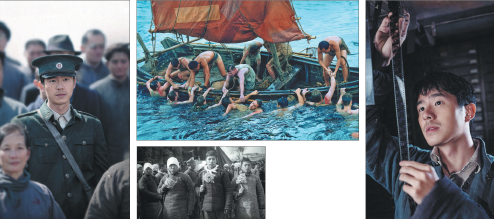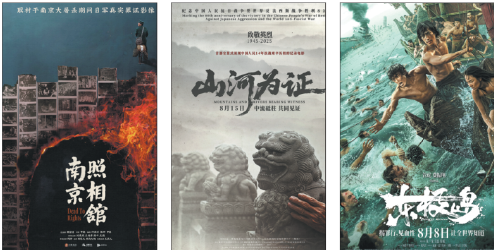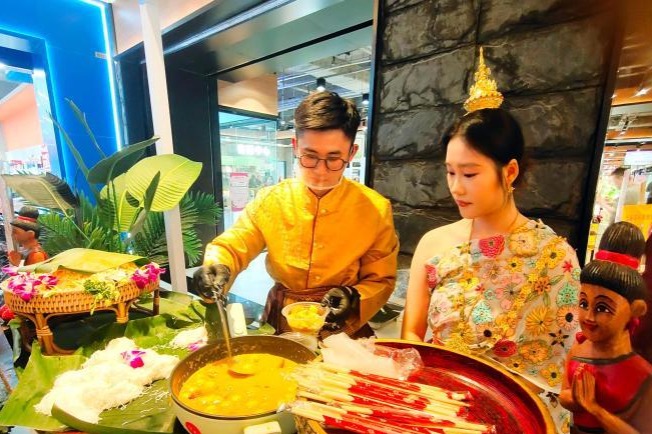Cinema reframes wartime memory
New Chinese films challenge false narratives to ensure truth and accuracy remain paramount in describing the history of resistance against aggression, Xu Fan reports.

In January 1938, just weeks after Japanese troops had taken Nanjing (in Jiangsu province), 15-year-old Luo Jin, an apprentice at a local photo studio, was handed two rolls of film by a Japanese officer to develop. What emerged shocked him — stark, irrefutable images of soldiers massacring unarmed civilians and assaulting women.
The Nanjing Massacre, which lasted from Dec 13,1937 to late January 1938, is regarded by historians as one of the worst atrocities of the 20th century. During this period, Japanese troops killed around 300,000 Chinese civilians and disarmed soldiers, and the city was devastated by rape and looting.
Outraged, Luo secretly printed an extra set of the photos, selecting 16 which he hid in a handmade album. Years later, these images became key evidence that forced Hisao Tani, a leading perpetrator, to confess.
Luo's story — along with the 1987 film Massacre in Nanjing and American missionary John Magee's surviving video footage — inspired director Shen Ao's latest movie, Dead to Rights.
Through cultural lens
As one of the most powerful Chinese movies commemorating the 80th anniversary of the victory in the Chinese People's War of Resistance Against Japanese Aggression and the World Anti-Fascist War, Dead to Rights has grossed 2.58 billion yuan ($359.3 million), topping the country's box-office charts in summer — a fiercely contested season running from June 1 to Aug 31.
Released on Aug 7 in Australia, New Zealand, the United States and Canada, it will soon expand to Malaysia, Singapore, Russia and South Korea.
Gaining fame from a series of films inspired by real-life incidents, with No More Bets being his previous most successful work, Shen employs a calm and restrained narrative to portray an ensemble of ordinary people turned heroes, including a postal worker, a little-known actress, a photo studio owner and his family, and a soldier.
Actor Liu Haoran plays Su Liuchang, a postal worker who escapes death by posing as a studio employee for a Japanese photographer. After leading Japanese soldiers to the studio, Su discovers the owner hiding in the basement with his wife and two children. Learning photo development on the spot, Su gains temporary protection and turns the studio into a refuge. When the rolls of film reveal Japanese atrocities, Su and fellow refugees risk everything to smuggle the evidence out to the world.
Shen says that he had grown up listening to wartime stories, as his grandfather had served in the New Fourth Army, a force led by the Communist Party of China to fight against Japanese invaders.
"When I was 12, I watched the film Massacre in Nanjing, which planted a seed in my heart," recalls Shen. After hearing the initial concept of Dead to Rights from scriptwriter Zhang Ke in 2023, he dove into books, documentaries and museum archives.
For the 1986-born director, the photos in the story carry more than historical weight. The film also portrays the Japanese staging fake scenes of harmony in Nanjing, photographing civilians in staged settings to mislead the world. The director points out that the Japanese in China fought not only a military war, but also a war for public opinion — a cultural war.
While many films focus solely on military conflict, Shen wants to highlight this lesser-told aspect: the manipulation of narratives and cultural invasion that ran alongside the violence.
Lesser-known tales
"Fascists developed a unique aesthetic during World War II — anti-human, anticivilization, but also extremely deceptive and misleading," says Zuo Heng, director of the film culture research department at the China Film Archive.
In Dead to Rights, the Japanese photographer claims to admire Confucianism. Yet, he twists its core virtues — benevolence, righteousness, propriety, wisdom and faith — to justify mass killings. The role is played by actor Daichi Harashima, who was born to a Japanese father and a Chinese mother.
Zuo, also an expert in cinema history, says that this year's domestic wartime films, such as Dead to Rights, reflect deeper historical thinking by Chinese filmmakers, expanding the lens beyond battlefield heroics to cultural and ideological struggles.
Apart from those on the Nanjing Massacre, the trauma that has shaped the collective memory of the Chinese people over generations, other films are revisiting overlooked stories of resistance such as like Dongji Rescue which has a stellar cast and the documentary Mountains and Rivers Bearing Witness.
Featuring a lot of underwater stunts filmed on a 9,000-square-meter sound-stage in Yangzhou (Jiangsu), Dongji Rescue is almost a feature-length dramatic remake of director Fang Li's documentary The Sinking of the Lisbon Maru, which garnered widespread acclaim last year.
Both films are inspired by the heroic actions of Chinese fishermen who, at the risk of their own lives, rescued 384 British prisoners of war from a sinking Japanese cargo ship during its voyage from Hong Kong to Japan in October 1942.
Actor Zhu Yilong, who plays a fisherman grieving the loss of his younger brother during the rescue, says that kindness is a fundamental trait of the Chinese people. And that is why China can rise again after every hardship, he adds.
Mountains and Rivers Bearing Witness comprehensively presents the Chinese people's arduous 14-year struggle against aggression, tracing events from the September 18 Incident in 1931 — which marked the outbreak of the war — to Japan's unconditional surrender on Aug 15, 1945.
The documentary was in production for over three years, with the crew visited 37 archives across the country to collect a wealth of rare photographs and video footage. Notably, 40 percent of the material is being screened for the first time.
Among the most valuable finds are film reels shot by former Soviet director Roman Karmen, who was dispatched to China in 1938 to document the Chinese resistance. Another rarely told aspect of history, featured in the film, is the presence of (former) Soviet Air Force volunteers who assisted Chinese pilots during the 1938 Battle of Wuhan, according to director Huang Yue.
Industry insiders say these productions reflect Chinese filmmakers' commitment to updating global audiences' understanding of China's role in achieving victory in the World Anti-Fascist War, while also asserting the nation's voice in shaping historical narratives.
In today's world, where some still try to distort history and justify acts of aggression, these films stand as a forceful rebuttal to historical nihilism, comments Li Zongyuan, curator of the Museum of the Communist Party of China, at the Beijing premiere of Mountains and Rivers Bearing Witness.



Today's Top News
- Healthy economic ties serve both sides
- China releases details of Huangyan Island nature reserve
- Xi congratulates president of Guyana on reelection
- Get the timing right to reduce 'debt cost' of natural disasters
- Advancing cooperation in global service trade urged
- PPI declines ease in Aug, first since Feb






























